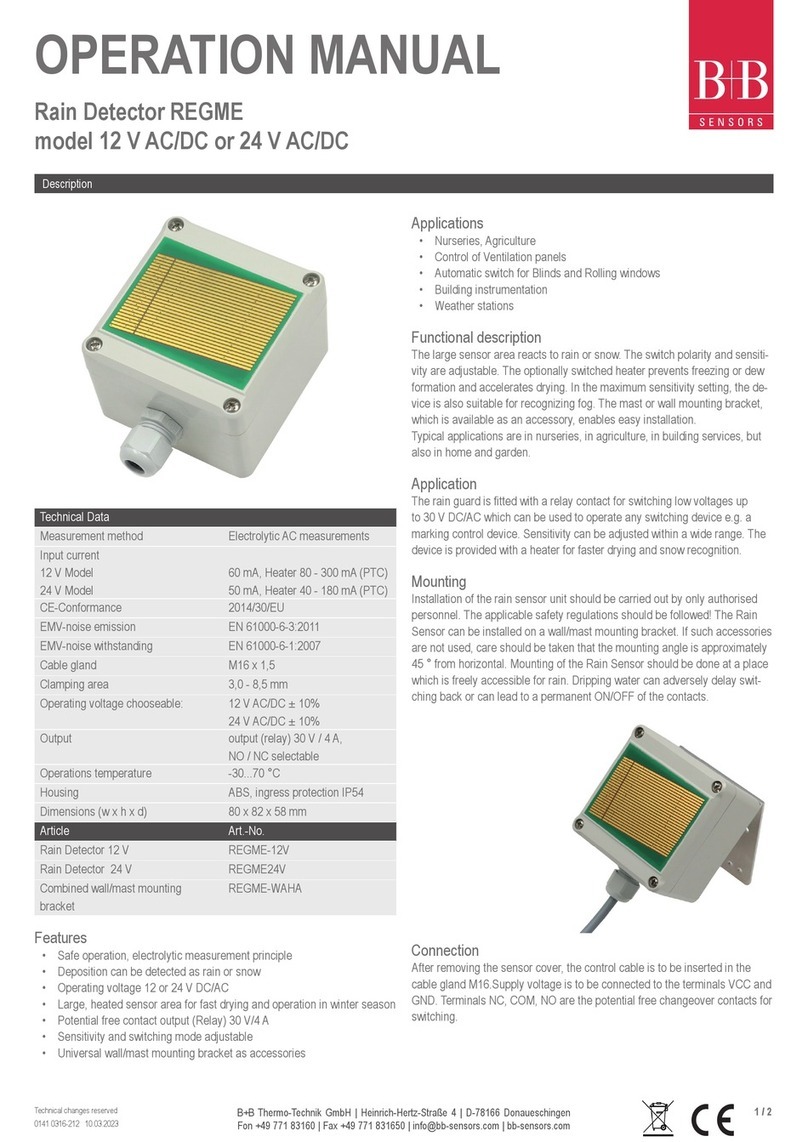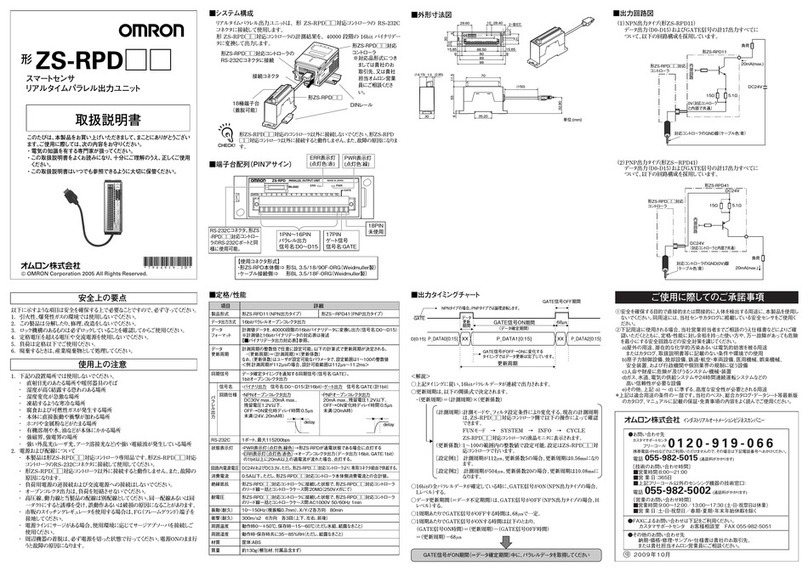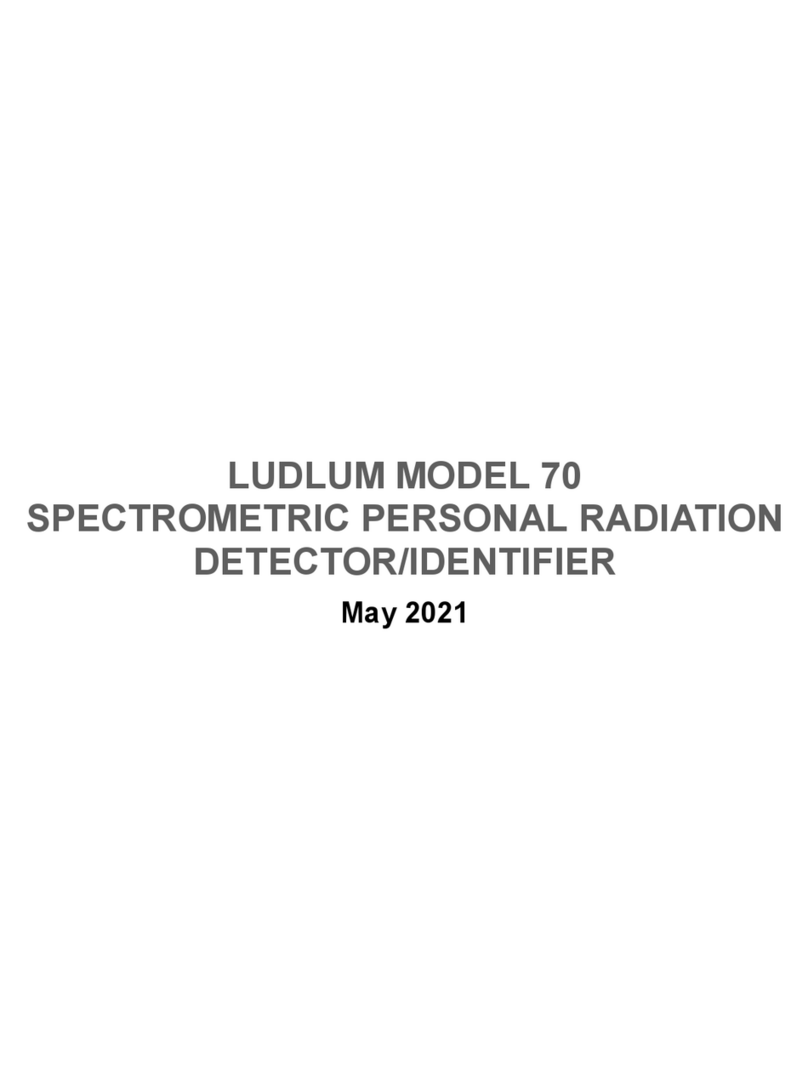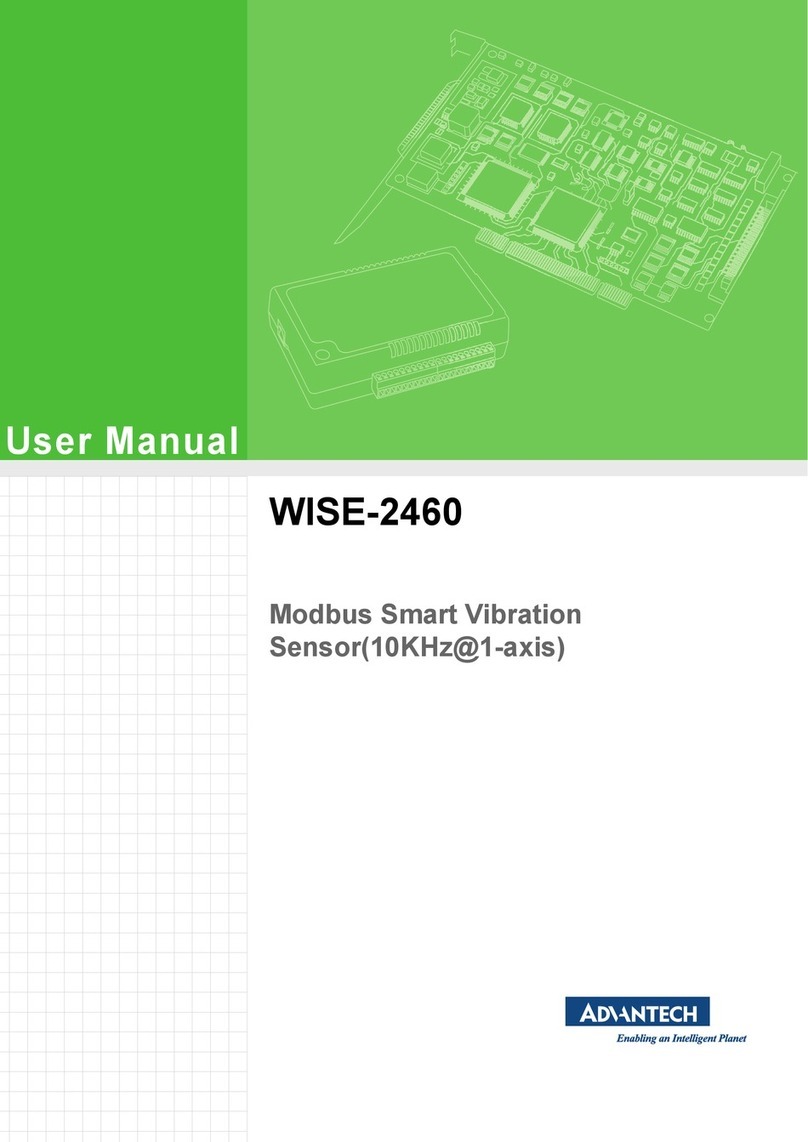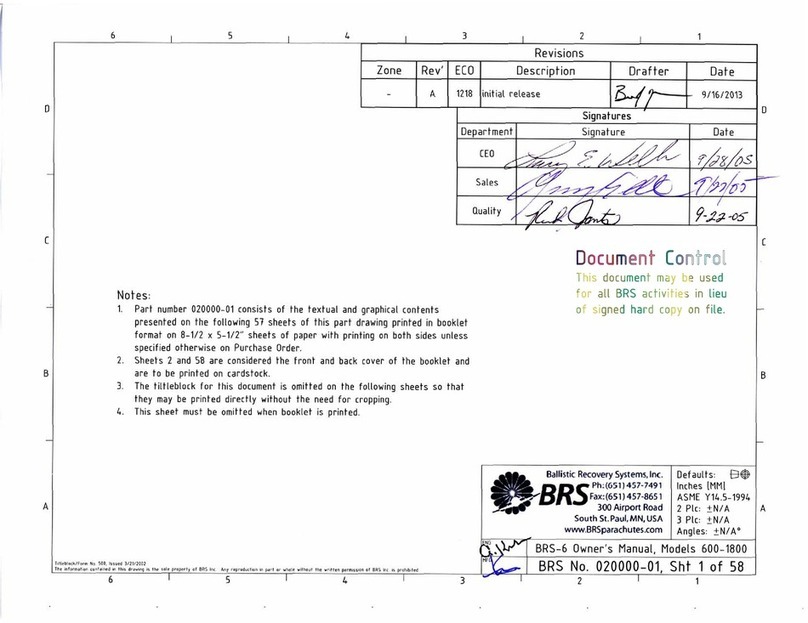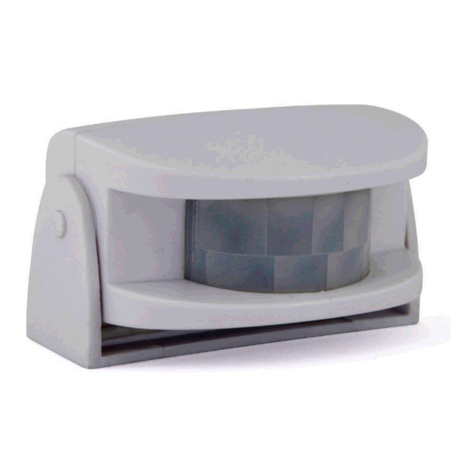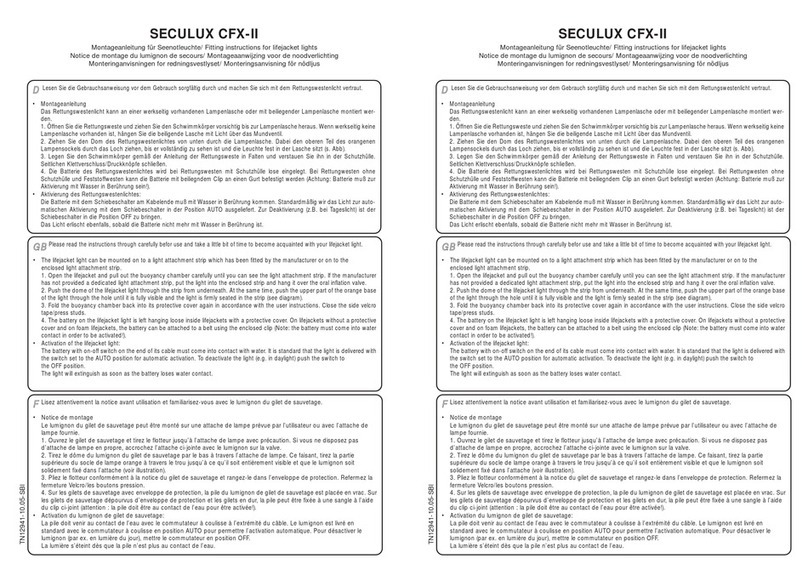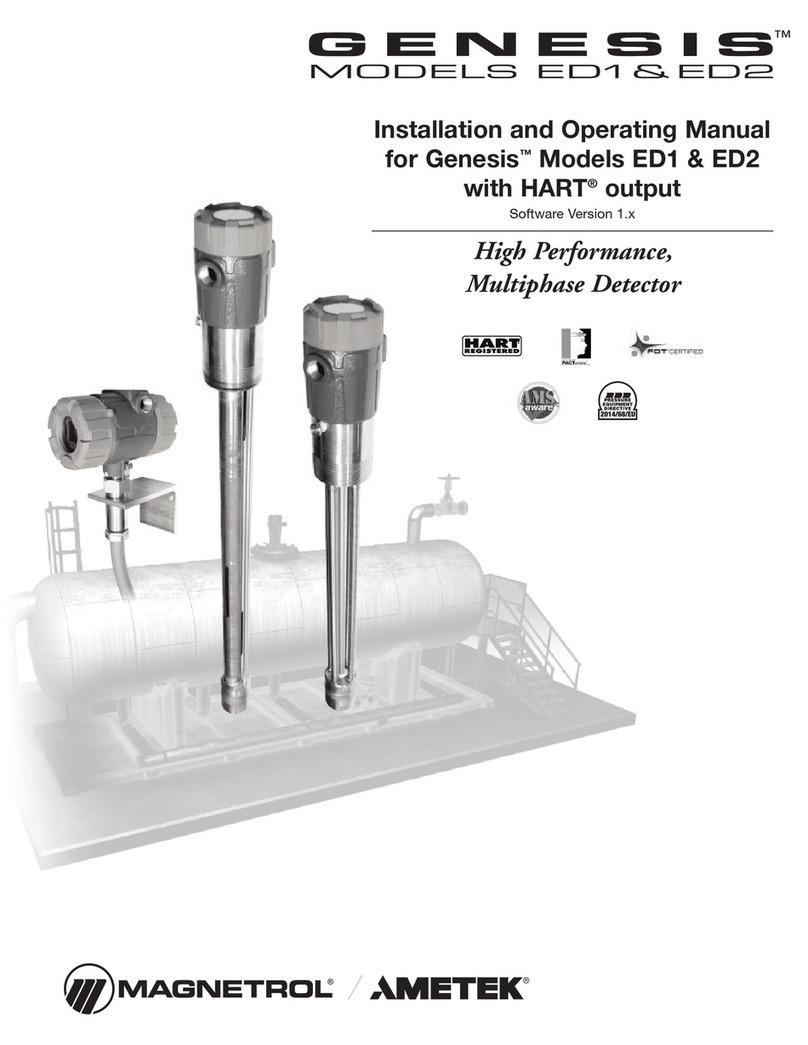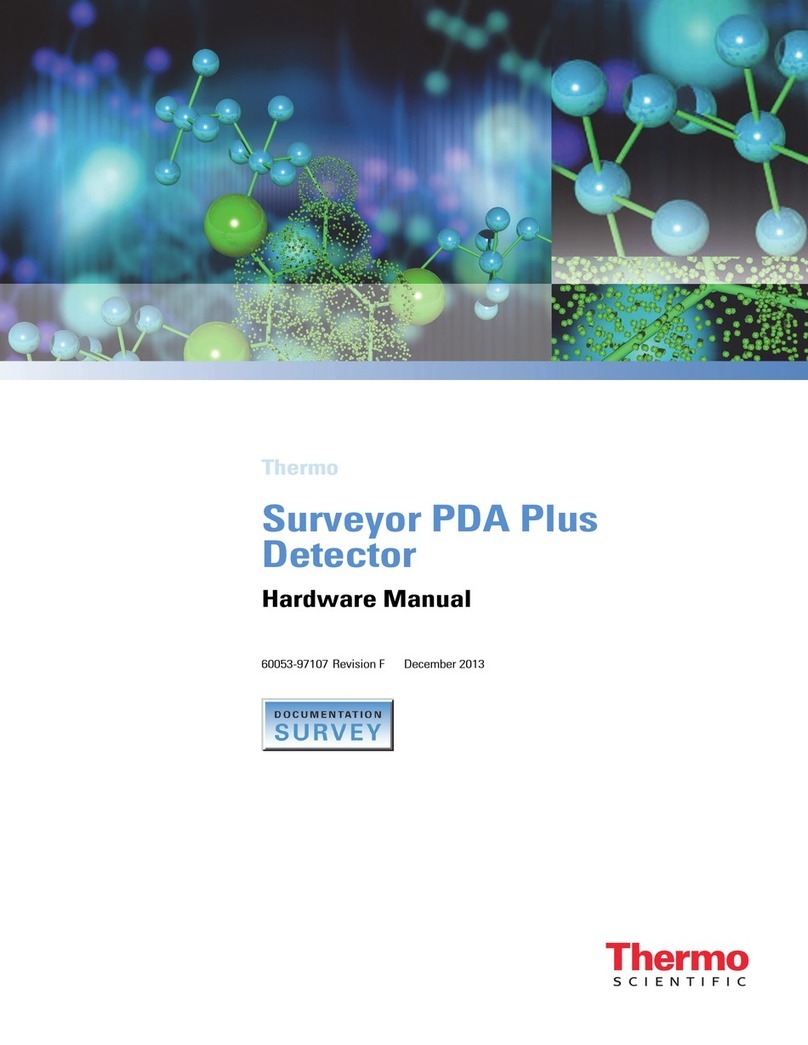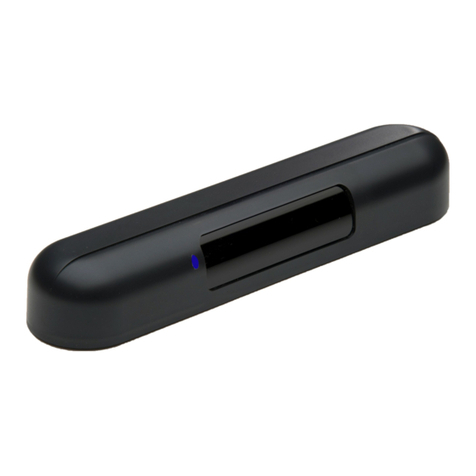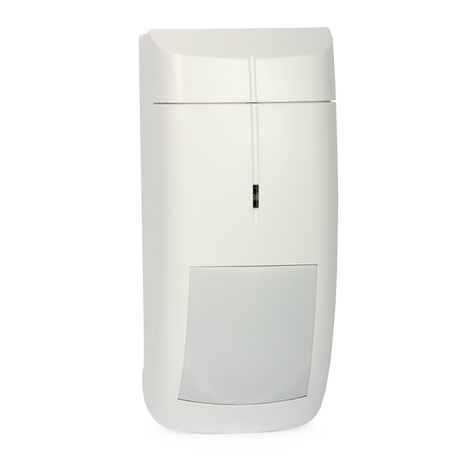B+B Sensors PIR-STD User manual

OPERATION MANUAL
Technical changes reserved
0141 0316-26 12.08.2015
Passive infrared motion detector
PIR-STD
DescriptionDescription
Technical data
Motion detector PIR-STD
Power supply 3...12 V DC
Input current Idle output “H” 1,0 mA
Active output “L“ 1,4 mA
Coverage Approx.4...12 m,
Adjustable in 4 steps through soldered
joints
Signal bandwidth 0,2...10 Hz
Coverage angle Horizontal ±50°
Vertical ±30°
Digital output Open Collector with pullup
max. 30 V, 20 mA
Analog output 0.5 Ub ± 0.5 Ub
Operating temperature
range
-20...+60 °C
Ambient humidity 0...90% RH
Dew formation not allowed
Dimensions 25x25x20 mm
Mounting diameter Ø24 mm
CE-Conformance 2004/108/EG
EMV-noise emission EN 61000-6-3:2011
EMV-noise withstanding EN 61000-6-1:2007
Ordering No. PIR-STD
Rights reserved for change in technical data due to technological
advancements!
Characteristic features
• Movement alarm unit with high sensitivity
• Very small dimensions
• For wall and ceiling mounting
• Horizontal preference characteristics
• Adjustable sensitivity
• Analog and digital output
• Wide coverage angle
• Interference proof circuit concept
• Simple mounting
•
Areas of application
• Automatic illumination control
• Alarm and security systems
• Presence detection, head counting
• Contact less hygiene switch
• Sanitary systems, water ttings
• Building instrumentation
• OEM-applications
Description
This miniaturized module is suitable for a large number of applications,
in which movement or presence is to be registered. The sensor reacts
to the heat radiation from body movement.
The sensitivity can be encoded in 4 steps through soldered joints,
which makes it possible for adaptation in different type of applications.
The adjustment range is right from a sensitive alarm generating unit to
an automatic switch for hygienic applications.
The window comparator integrated in the module, delivers a digital
switching signal on detecting a movement, which is TTL and CMOS
compatible and can be further processed by a micro controller or a
timer.
The amplitude of signal at the analog output depends on the infrared
radiation difference and is good enough for suitable triggering within
the operating voltage limits. The angular speed of the object can be
judged from the frequency. The potential at the reference voltage
output lies in the middle of the triggering range.
B+B Thermo-Technik GmbH | Heinrich-Hertz-Straße 4 | D-78166 Donaueschingen
1 / 3

OPERATION MANUAL
Technical changes reserved
0141 0316-26 12.08.2015
Passive infrared motion detector
PIR-STD
Sensitivity adjustment
There are four soldered joints on the back side of the module. By
closing (over-soldering) one of the jumpers, the sensitivity of the
module can be reduced.
Connector conguration
Pin Desc. Function Remarks
1 ANA Analog output 0V...VCC
2 REF Reference voltage Approx. VCC / 2
3 GND Ground GND
4 OUT Switching output O.C. max. 20 mA
5 GND Ground GND
6 VCC Operating voltage 3...12 V DC/ 1.4mA
7 LDR Optical resistance Optional LDR
8 LDR Optical resistance Optional LDR
Method of operation
PIR alarm units operate with pyro-electric sensors, which show maxi-
mum sensitivity under the effect of heat radiation from living bodies.
At 37° body temperature, the spectral sensitivity lies between 7 and
14 µm. The inner construction of PIR sensors is segmented, i.e. two
or more individual elements are interconnected within the unit, so
that they mutually compensate with each other. With this arrange-
ment, the self-temperature of sensor is compensated. A MOSFET
is integrated in the sensor as an impedance converter because
the pyro-elements can be driven only by high ohmic value. In the
following evaluation circuit, the change in output voltage is evaluated
and DC component is separated out by a high pass lter.In simple
devices, normally a double element sensor is used which show a
horizontal preferred direction. The mounting direction of such sensors
is also indicated accordingly and it must be noted before putting into
application. For mounting in ceiling, four element sensors are more
suitable, with which semi-spherical characteristics can be achieved.
Lens
A change in output voltage occurs only when the part segments of
sensor experience different levels of infrared radiation. Hence optics
or a special Fresnel lens is required which can divide the space in
front of the sensor element into segments and in turn makes an
image of the part segment of the sensor. If someone looks at the
overall system covering optics, sensor and evaluation circuit, then he
can realise that there is a considerable contribution of the lens on the
capability of the system.
Bandwidth
The change in sensor signal is further processed by only an evalua-
tion circuit. The correct magnitude of band pass lter characteristics
decides the capacity of the circuit: Depending on the lens and angular
speed of the object, a signal between a bandwidth of 0.05 and 25
Hz normally comes out. But rst of all, it should be noted that for
a wide range, the lower frequency limit should not be selected too
high, otherwise there is a sensitivity loss in case of slow movements.
The upper frequency limit decides the sensitivity for fast movements
and should be kept much away from power line frequency to avoid
interference effect.
Signal evaluation
For simple requirements, the window comparator available on the
module is sufcient for signal evaluation. As soon as the signal level
at the output of amplier exceeds a certain limit, a digital switching
signal is generated which can be further processed.
For more meticulous jobs, it is better to analyse the pattern of output
signal. From the signal amplitude, one can derive the spacing or size
and from signal frequency, the angular speed of the moved object
is inferred. The signal pattern contains information about the course
of movement. A micro-controller can certainly improve the detection
effectiveness and can exclude false alarms, which is most required in
case of alarm generating units.
In addition to the digital output, our movement alarm units are also
provided with an analog output, which stands in line with the amplied
signal. Hence, integration is also possible with intelligent OEM-
systems.
B+B Thermo-Technik GmbH | Heinrich-Hertz-Straße 4 | D-78166 Donaueschingen
2 / 3

OPERATION MANUAL
Technical changes reserved
0141 0316-26 12.08.2015
Passive infrared motion detector
PIR-STD
Circuit diagram
Room segments
Attention
Please avoid extreme mechanical and inappropriate exposure.
The device/product is not suitable for potential explosive areas and
medical-technical applications.
B+B Thermo-Technik GmbH | Heinrich-Hertz-Straße 4 | D-78166 Donaueschingen
3 / 3
Other B+B Sensors Security Sensor manuals

